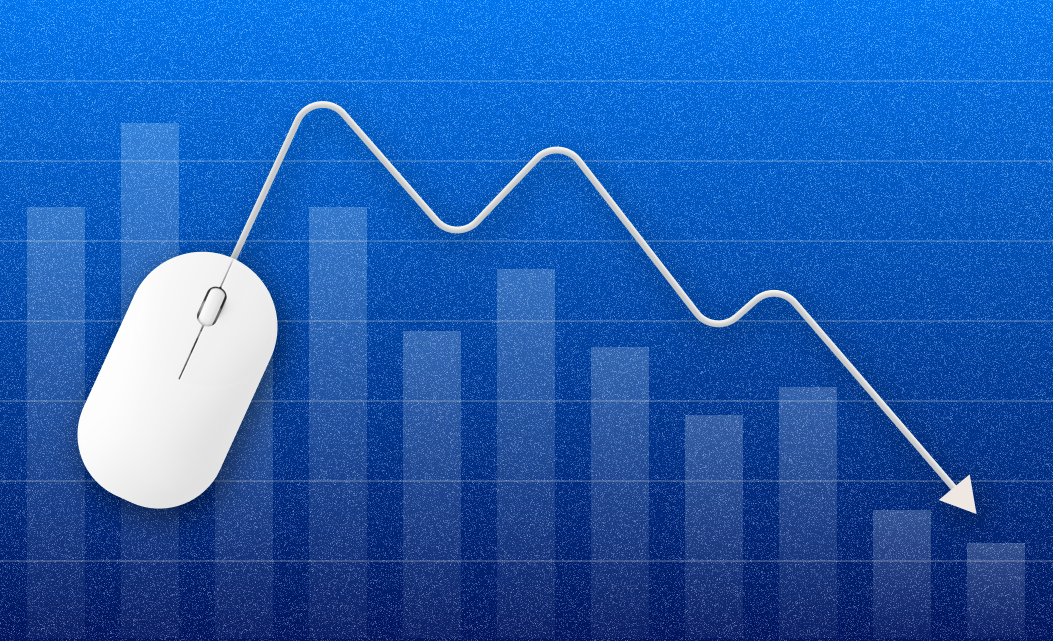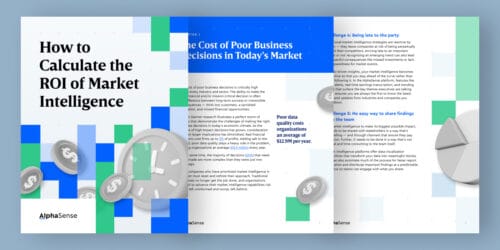How to Calculate the ROI of Market Intelligence
Get the guide
The threat of recession has left most sectors preparing for the unexpected.
Disproportionately affected, technology companies have experienced the brunt of what’s to come: supply chain problems brought on by macroeconomic events, slowing consumer demand, and looming layoffs. To survive what economists are predicting to unfold in 2023, tech leaders are investing in market intelligence tools to not only strategize how they’ll make ends meet, but also to hit their targets in an unpredictable market.
In a time of downturn, any cost that maintains or even propels business is an investment–and market intelligence tools provide high ROI, especially as a potential recession looms. There are always growth opportunities hidden within the market. With market intelligence tools, particularly those with AI search capabilities, you can take the dirty work out of identifying them so you never miss a lucrative market signal or incorrectly forecast revenue.
Luckily, we have a comprehensive breakdown of how market intelligence tools can help you plan for various economic scenarios, react quickly to changing market conditions, pinpoint growth opportunities in your industry, reduce turnover, and make your company more recession-resistant.
Related Reading: 8 Market Analysis Tools for 2023
10 Market Research Tools to Trial in 2023
Becoming Recession Resistant
As the consequences of a recession creep into focus, faith in the tech market has weakened at an accelerated rate. But, regardless of waning faith, analysts and investors strongly believe there are still opportunities to make money–as long as you know where to look. And that’s what market intelligence platforms promise: to aggregate information and provide a comprehensive overview of the market so you can spot revenue-generating opportunities before your competitors.
While all sectors have already felt some impact from recent macroeconomic events, the tech industry is at the front and center of concern over who will suffer the most. Though this current hyperfocus on the tech industry feels eerily similar to the issues they weathered in 2000 and 2008, they’re still a long way to go to match those troubled years. Yet, despite macro headwinds in past recessions, tech companies still delivered double-digit growth. For example, during the U.S. financial crisis, the median SaaS company grew by 18% in 2009.
The general consensus from various documents within the AlphaSense platform expressed optimism, with many companies beginning to integrate more recession-proof work into their operations and portfolios. Utilizing sentiment analysis, we can deduce that tech companies have expressed cautious optimism. Market intelligence tools that utilize proprietary AI and NLP technology, like AlphaSense, track sentiment across themes found in earnings releases and other company documents.
Market intelligence platforms have allowed companies and their competitors to make real-time decisions, without wasting time on having to gather and synthesize the daily deluge of data. By aggregating multiple disparate content sets into one place, platforms like AlphaSense enable you to spend less time searching for relevant information and more time analyzing and validating your strategies. Traditional search engines aren’t B2B search tools, and won’t give your team the insights you need to act on real-time market signals. If you’re relying on point-in-time data, manual searches, and gathering info from disparate sources, you’ll find yourself stuck in an endless cycle of haphazard attempts to synthesize any new information that falls into your lap.
Looking into Layoffs
Over 41,000 tech workers have been laid off this year alone, according to Crunchbase, with leading companies like Snapchat, Microsoft, Oracle and Netflix, letting go of hundreds of their employees. Even Apple and Google have slowed or frozen hiring for a number of roles. This reprioritization of workforces is a response to the labor market downturn economists and investors are predicting, and the Federal Reserve’s decision to raise interest rates in an effort to cool consumer demand and bring inflation under control.
While this wave of tech layoffs may be concerning, it might also be an indication that we could return to more normal levels of hiring. In the early aughts of the pandemic, a cohort of companies began employing more individuals as work-from-home became the new norm. And even today, the overall labor market still looks resilient.
Tech sector companies added 25,500 net new workers in August, with growth in five major occupation categories, according to information sourced within AlphaSense. Tech industry employment has increased by 175,700 jobs in 2022 and is tracking 46% ahead of last year and 92% ahead of 2019. Companies throughout the economy added an estimated 21,000 tech workers for August 2022. The unemployment rate for tech occupations was 2.3%–significantly lower than the national unemployment rate (3.7%). Employer job postings for tech positions eased back in August, coming in at just under 320,000.
“Stability in tech hiring continues to be an overarching theme this year,” said Tim Herbert, chief research officer at CompTIA. “Despite all the economic noise and pockets of layoffs, aggregate tech hiring remains consistently positive.”
In order to stay ahead of the news that’s important to you, you need a market intelligence platform that keeps you up to date. With AlphaSense, you can get email alerts delivered straight to your inbox daily, weekly, or every time there’s a relevant mention of a company or theme you’re following. This will ensure you never miss a significant piece of information happening outside of business hours in your vertical. Alerts should not only notify you that a certain trend has been mentioned, but also include relevant snippets pulled from source materials so that you can quickly review and get context for the mention right away in your inbox.
Sorting Out Supply Chain Issues
Since the onset of the COVID-19 pandemic, supply chain delays have caused dangerously low semiconductor stockpiles for international tech manufacturers.
Taiwan Semiconductor Manufacturing Co. produces roughly 90% of microchips found in everything from mobile phones to the medical research tools central to fighting the COVID-19 pandemic. Tensions have steadily risen over the company’s supply control. How Chinese leader Xi Jinping’s plans to reunify Taiwan under Beijing–namely the potential occupation of TSMC’s fabs—could disrupt the global supply chain. So how are some tech leaders in the industry responding to this crisis?
Intel Corp. recently announced that the company will acquire Tower Semiconductor, a leading foundry for analog semiconductor solutions, for $53 per share in cash, representing a total enterprise value of $5.4 billion. The acquisition significantly advances Intel’s strategy to further expand its manufacturing capacity, global footprint, and technology portfolio to address unprecedented industry demand.
Last year, Apple, Amazon, Facebook, Tesla, and Baidu distanced themselves from established chip firms and began bringing elements of semiconductor development in house. In 2020, Apple declared they would stop using Intel’s x86 architecture to make its own M1 processor, which are now used in iMacs and iPads. More recently, Tesla said it would be building a “Dojo” chip to train artificial intelligence networks in data centers. And even last month, Baidu launched the “Kunlun 2” AI chip that’s designed to help devices process huge amounts of data and boost computing power.
Competitive advantage is at the heart of tackling supply chain disruptions, and staying ahead of your competition means tracking their every move. To do so, you need a market intelligence platform that monitors and informs you of the above developments and more, all in real-time. AlphaSense users can create watchlists of the specific companies they want to track and receive critical info on them through alerts. You can also understand how a specific set of companies are approaching industry-changing topics by searching across documents tagged to companies within your watchlist. Keep tabs on how your peers are managing the semiconductor shortage, who their chip suppliers are, and what their strategy for microchip acquisition is next quarter. Want to see this in action? Check out the first blog in our four-part series on market and competitive landscaping, How To Conduct a Competitive and Market Landscape Analysis.
Finding Opportunities for Growth
There’s never time to delay finding your next growth opportunity, regardless of a downturn. In the TMT sector, it’s grow or die—and with the help of market intelligence, you can ensure that you’re setting yourself up for success. When picking the right market intelligence platform, it should function as an efficient and accessible tool that your team can rely on to take a lead in the race for information.
In a time where new data is so abundant that it is nearly impossible to stay ahead of developing competitive insights, depending on a market intelligence platform is critical to helping you cut through the noise and find growth opportunities in the midst of a volatile market. Potentially more important, you never want to overlook an opportunity that your competitors might seize.
A platform should eliminate the potentially fruitless hours of research you and your team would spend so that you can spend more time strategizing based on your findings. AlphaSense expands keyword and thematic searches to deliver the most relevant results on a topic with synonym recognition technology called Smart Synonyms. For example, when searching the phrase “electric vehicles” in AlphaSense, your results will surface all relevant information for electric vehicles, including “autonomous” and “self-driving.”
Aside from the hours of manual searching, acting on an opportunity before your competitors requires trustworthy sources of information to fuel confident decision-making. This sort of information does not live in public search engines that anyone can access. You need intel from industry leaders and analysts from the top brokerage firms to get the full picture. If you want to be the anchor for your company’s strategy team, you first need to level up the quality of your information game. Your market research platform should be pulling information from the four perspectives:
- The company voice
- The analyst’s voice
- The journalist’s & regulatory voice
- The expert’s voice
Only by accessing all of these four essential perspectives, can users see the complete picture of a company, industry, competitive set, or trend.
Once you’ve collected the information you need, you’ll need to signal your next move to the market. Messaging can be just as important as the stats you’re sharing, especially for those in investor relations. Access to a platform that houses searchable earnings and event transcripts can be key in crafting an investor-friendly statement. If you want to catch attention on Wall Street, leverage transcripts and learn the language leading brokerages to pack your opportunity with a punch.
Learn how a leader in materials manufacturing solutions for the world’s preeminent semiconductor and display equipment company not only gained speed but increased confidence in their research by using AlphaSense to synthesize important information all in one platform. But don’t just take our word for it: “We’re seen as research experts. The Information Center has been completely amplified within the business over the past couple of years, in part, due to the efficiencies gained in using AlphaSense’s AI tools” – Manager and Information Specialist.
Read more in our case study, How a semiconductor leader improved market intelligence with AI.
Don’t miss our Innovator’s Guide to Competitive Intelligence that will help take your research strategy from reactive to proactive.





